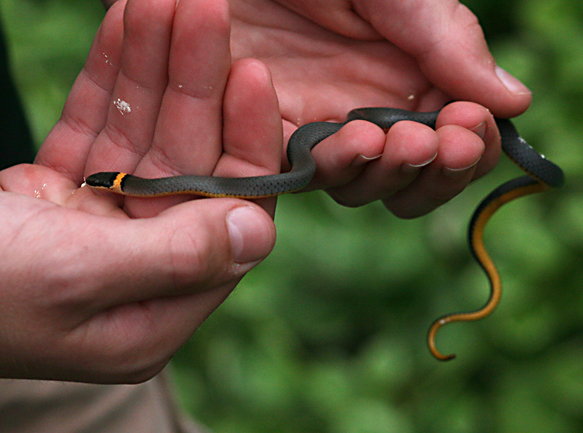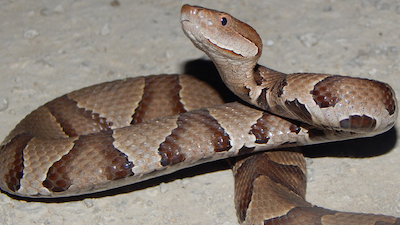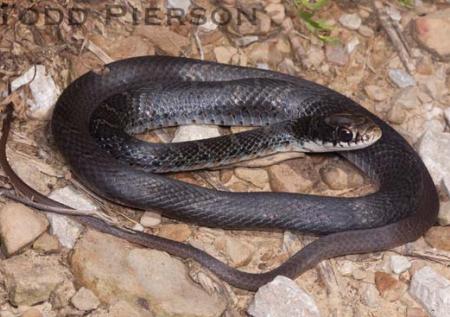Snakes in Your Garden, Friends or Foes?
by Carolyn R. Casey, Fairfax Master Gardener

Eastern garter snake
While walking and weeding in my garden last spring, I noticed a very quick and sudden movement that startled me. My curiosity got the better of me, and I decided that I must find out what new and previously unseen creature was in my garden. Then I came upon a snake. What type of snake is this, is it poisonous and why is it in my garden? Many cringe at the word ‘snake’ and believe that all snakes are dangerous and need to be killed. The fear of snakes is often due to childhood experiences and misinformation. My research replaced myths and fear with facts leading to interest and appreciation for the help that snakes provide in controlling pests in our yards and gardens.
Snakes in Fairfax County
The snake in my garden was an Eastern Garter Snake (Thamnophis sirtalis). Thamnos means ‘bush’ and ophio means ‘snake.’ These snakes are native to North America and can be 16 in. to 26 in. (40 to 60 cm) long. They are black, brown, gray or olive, with three stripes that are either white or yellow that run the length of their bodies. Sometimes the stripes on the sides are absent or more resemble a checkered pattern. They are nicknamed ‘garden’ snakes since that is where unsuspecting gardeners encounter them. Garter snakes are active throughout the day and on sunny days can be seen basking on rocks, sidewalks, decks and even patios. On hot days or while sleeping, they can be found under foundations, rocks, logs, stumps or porches. They are extremely helpful predators in the garden since they eat moles, voles, mice, salamanders, slugs, insects and grasshoppers.
I have also encountered the Eastern Ratsnake (Pantherophis alleghaniensis) in both of its juvenile and adult colorations. Pantherophis comes from the Greek word meaning ‘panther’ and ophis meaning ‘snake.’ This is the most commonly encountered snake in Virginia. The adult body is uniformly black on the back. The belly has an irregular black and white checkerboard pattern, particularly toward the head. The chin and throat are cream or white colored. Juvenile snakes have black to dark brown blotches on their backs and peppered black and white to gray bodies. They also have a diagonal dark eye stripe. The diet of Eastern Ratsnakes consists of moles, chipmunks, gray squirrels, Eastern cottontails, white-footed mice and voles. (The white-footed mouse is a major carrier of the blacklegged tick, known as the deer tick, the primary vector of Lyme disease.) The Eastern Ratsnake may grow to be 42 in. to 72 in. (1 to 2 m).

Ring-necked snake
The DeKay’s Brownsnake (Storeria dekayi) is a mere 9 in. to 13 in. (22 to 33 cm) long snake with a very small “home” range. In a year, this snake may move about 200 feet from your garden to your neighbor’s woodpile. The DeKay Brownsnake was named Storeria in honor of David Humphreys Storer, an 18th century zoologist from New England and dekayi was in honor of James Ellsworth Dekay, a 19th century naturalist. These snakes are light brown or gray to dark brown or almost black. They have pairs of black spots, and their skin is lighter than the rest of the body between the spots. Brownsnakes primarily eat earthworms, slugs and snails, using their tiny, slender teeth to extract snails from their shells. Keeping this slug predator around could be beneficial to your hostas and other prized plants.
The Northern Ring-Necked Snake (Diadophis punctatus edwardsii) is seen statewide and is the most common snake in Shenandoah National Park. Diadophis means ‘headband’ and ophis means ‘snake.’ The adult snakes are gray to bluish black on their backs with flat black heads. Their neck rings and ventral color vary from yellowish to reddish. Their bellies are unmarked or have a row of dark, half-moon-shaped spots along their length. The juvenile snakes have a velvety black dorsum and even blacker heads. Most adults are from 10 in. to 15 in. (25 to 38 cm) long. They eat earthworms, salamanders and lizards.

Eastern copperhead
The Eastern Copperhead (Agkistrodon contortrix) is formerly called the Northern Copperhead. It is the only venomous snake species commonly found in Fairfax County. Agkistrodon is derived from the Greek word ancistron that means ‘fishhook,’ a reference to its recurved fangs. Contortrix is from the Latin word contortus meaning ‘twisted’ or ‘intricate’ in reference to its dorsal pattern. Copperheads may be found basking in the sun on trails, in rocky areas and in stream valleys. They are most active between April and October.
Copperheads can be identified by their triangular head shape. They have small holes between the eye and nostril on each side of their heads, known as heat sensing pits. They also have vertical pupils (like a cat’s pupils), an hourglass scale pattern that runs the length of their bodies, and crossbands that are copper, light brown or tan color. The juveniles have yellow-tipped tails. They usually are 24 in. to 36 in. (60 to 90 cm) long. They eat mice, frogs, toads, insects (like cicadas), caterpillars, salamanders, small birds and shrews.
Living with Snakes on Your Property
Repellents do not work to keep snakes away. The best way to deal with snakes is to remove denning and sleeping areas like rocks and log piles. Snakes use these areas to avoid predators and to control body temperature. Clean up spilled seed from bird feeders that can become a food source for snakes and for rodents that snakes eat. Mow your lawn short and trim shrubs and trees away from your home. Put rubber seals on the bottom of garage and shed doors to keep snakes out. Examine your home’s foundation since snakes will use basements or old cisterns to hibernate. Snakes will hibernate from November until March, so seal cracks and crevices before this. A 1/4 inch-hole (5 mm) is large enough for some snakes to enter.

Black Racer
The Audubon Society Field Guide to Reptiles and Amphibians is a good resource to help identify snakes. Juvenile snakes have different markings than adults. It is illegal to kill a snake in Virginia and in many other states, unless it is a threat to health or property. Snakes have several predators: crows, hawks, owls, raccoons, foxes, skunks and opossums. No data indicate that snake parasites or diseases in wild populations transfer to humans or mammalian pets.
Snakes can climb so do not be surprised if you see a snake in a tree, shrub or vine. I have seen a very long black snake resting in one of my azaleas and have also seen a small garter snake curled up and resting in my Pieris japonica. I have read that snakes climb to escape a predator.
The next time you see a snake in your garden, take some steps to identify and learn about the species. Create a symbiotic relationship with the snakes in your garden! Happy Gardening!
Resources
Managing Human Wildlife Interactions: Snakes, Jim Parkhurst, Virginia Cooperative Extension
Critters in the Garden, Stephen Church, Piedmont Master Gardeners
Snakes of Virginia, Virginia Herpetological Society
Your Guide to Snakes in Fairfax County, Fairfax County Government News Center
Snake Awareness, County of Fairfax Virginia